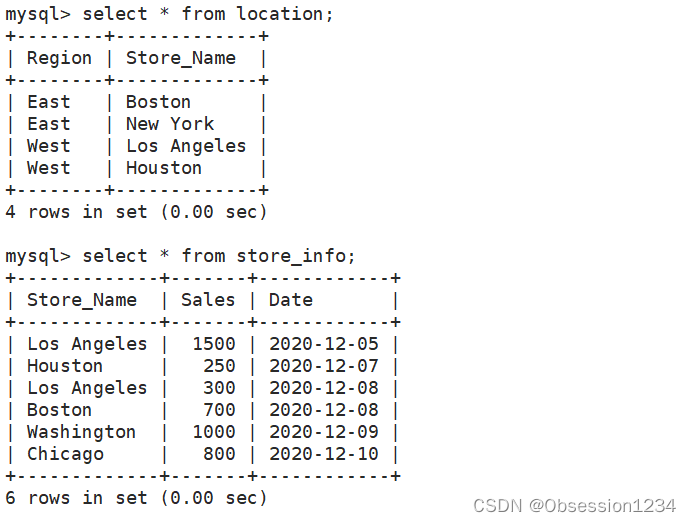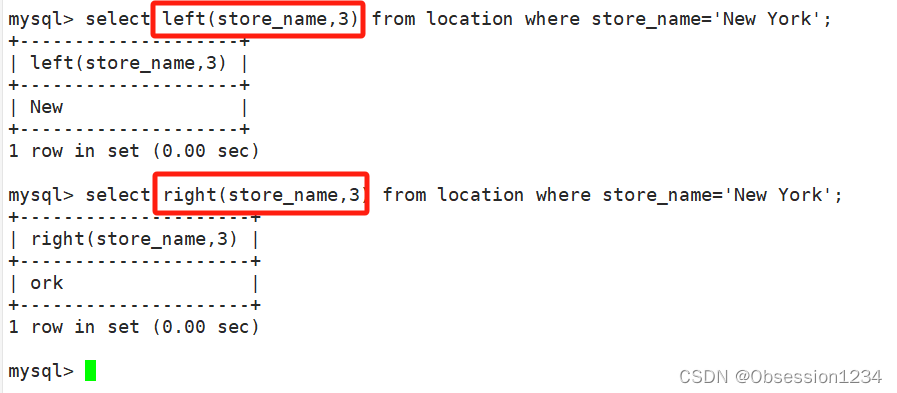前言:
MySQL 查询数据的执行过程
- 客户端向 MySQL 服务器发送一条查询请求,连接器负责处理连接,并进行身份验证和权限控制。
- MySQL 先检查查询缓存,如果命中缓存,则立刻返回存储在缓存中的结果;否则使用查询解析器进行SQL语句解析、预处理,再由优化器生成对应的执行计划。
- MySQL 根据执行计划,调用存储引擎来执行查询。
- 将结果返回给客户端,同时缓存查询结果。
创建两个表,并插入数据,作为操作对象
use mydb;
create table location (Region char(20),Store_Name char(20));
insert into location values('East','Boston');
insert into location values('East','New York');
insert into location values('West','Los Angeles');
insert into location values('West','Houston');
create table store_info (Store_Name char(20),Sales int(10),Date char(10));
insert into store_info values('Los Angeles','1500','2020-12-05');
insert into store_info values('Houston','250','2020-12-07');
insert into store_info values('Los Angeles','300','2020-12-08');
insert into store_info values('Boston','700','2020-12-08');
insert into store_info values('Washington','1000','2020-12-09');
insert into store_info values('Chicago','800','2020-12-10');
use mydb;
create table location (Region char(20),Store_Name char(20));
insert into location values('East','Boston');
insert into location values('East','New York');
insert into location values('West','Los Angeles');
insert into location values('West','Houston');
create table store_info (Store_Name char(20),Sales int(10),Date char(10));
insert into store_info values('Los Angeles','1500','2020-12-05');
insert into store_info values('Houston','250','2020-12-07');
insert into store_info values('Los Angeles','300','2020-12-08');
insert into store_info values('Boston','700','2020-12-08');
insert into store_info values('Washington','1000','2020-12-09');
insert into store_info values('Chicago','800','2020-12-10');
一.MySQL进阶查询
1.select
显示表格中一个或数个字段的所有数据记录
语法:select "字段" from "表名";
select store_name from store_info;
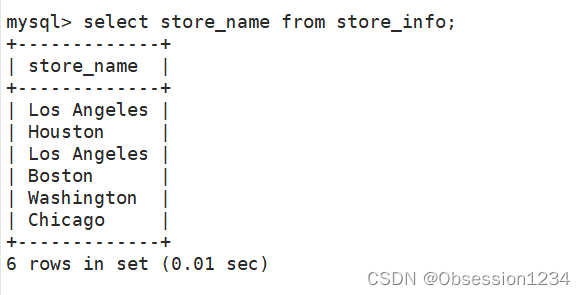
2.distinct
不显示重复的数据记录
语法:select distinct "字段" from "表名";
select distinct store_name from store_info;

3.where
有条件查询
语法:select "字段" from "表名" where "条件";
select store_name from store_info where sales > 1000;
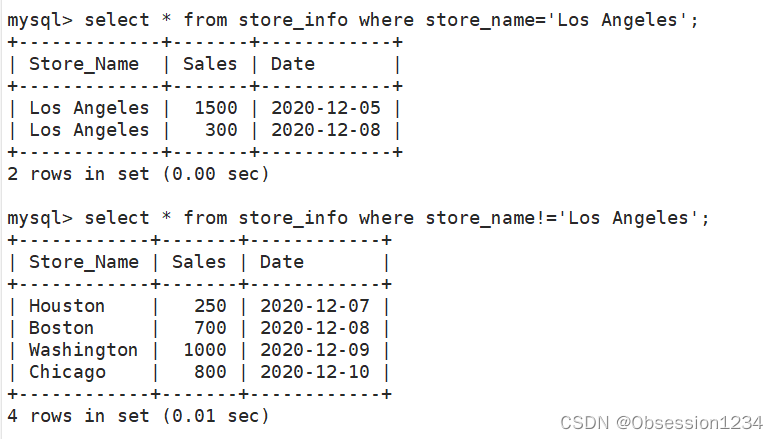
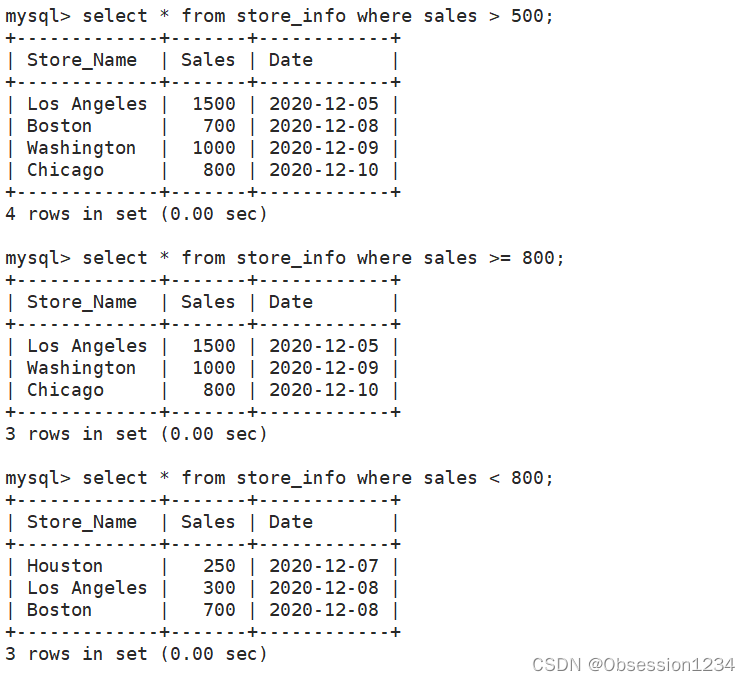
4.and、or 且、或
语法:select "字段" from "表名" where "条件1" {[and | or] "条件2"};
select * from store_info where sales > 500 and sales < 1000;
select * from store_info where store_name='Log angeles' or store_name='Hoston';
select * from store_info where (store_name='Log angeles' or store_name='Hoston');
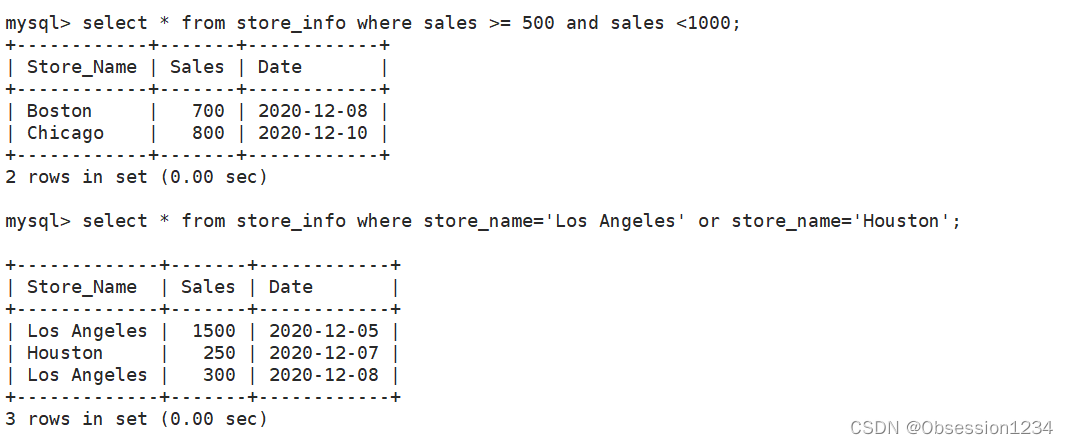

5.in
显示已知的值的数据记录
语法:select "字段" from "表名" where "字段" in ('值1', '值2', ...);
select * from store_info where store_name in ('Los Angeles', 'Houston');
#显示包含这两个数据的内容
select * from store_info where store_name not in ('Los Angeles', 'Houston');
#显示不包含这两个数据的内容
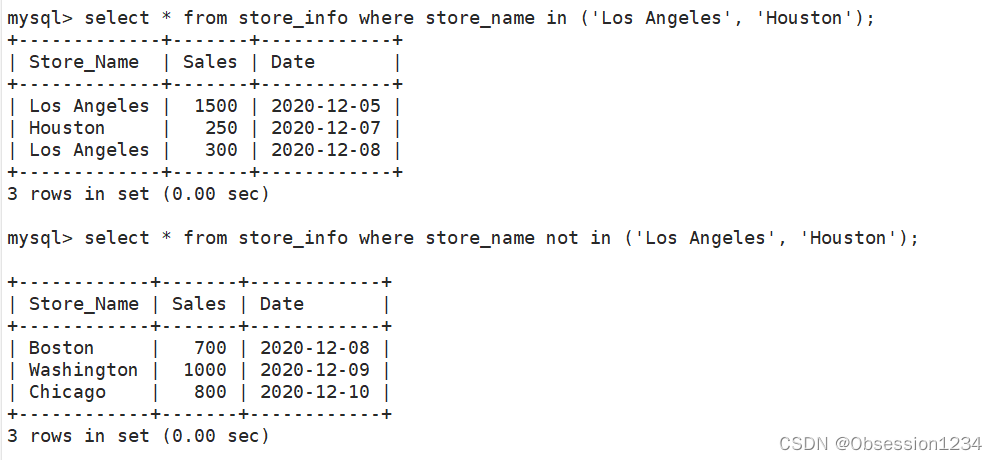
6.between
显示两个值范围内的数据记录
语法:select "字段" from "表名" where "字段" between '值1' and '值2';
select * from store_info where date between '2020-12-07' and '2020-12-09';
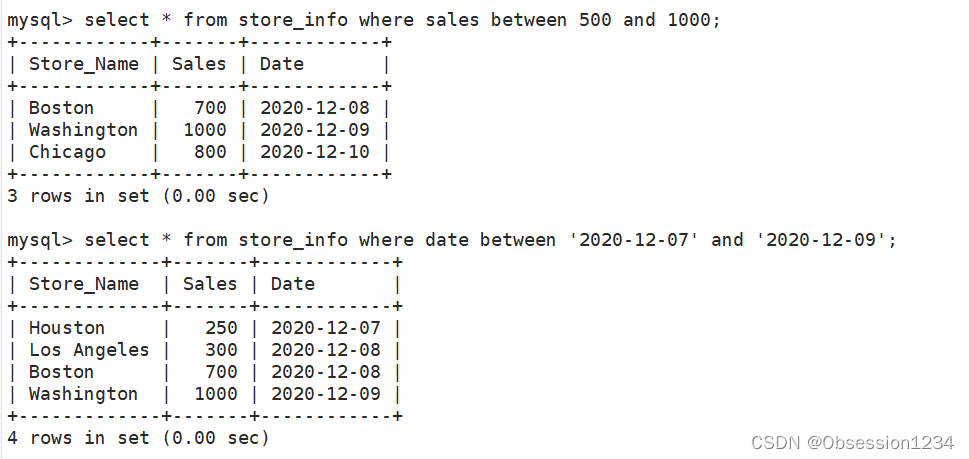
7.通配符
通常通配符都是跟 like 一起使用的
% :百分号表示零个、一个或多个字符
_ :下划线表示单个字符
'A_Z':所有以 'A' 起头,另一个任何值的字符,且以 'Z' 为结尾的字符串。
例如,'ABZ' 和 'A2Z' 都符合这一个模式,而 'AKKZ' 并不符合 (因为在 A 和 Z 之间有两个字符,而不是一个字符)。
'ABC%': 所有以 'ABC' 起头的字符串。
例如,'ABCD' 和 'ABCABC' 都符合这个模式。
'%XYZ': 所有以 'XYZ' 结尾的字符串。
例如,'WXYZ' 和 'ZZXYZ' 都符合这个模式。
'%AN%': 所有含有 'AN'这个模式的字符串。
例如,'LOS ANGELES' 和 'SAN FRANCISCO' 都符合这个模式。
'_AN%':所有第二个字母为 'A' 和第三个字母为 'N' 的字符串。
例如,'SAN FRANCISCO' 符合这个模式,而 'LOS ANGELES' 则不符合这个模式。
8.like
匹配一个模式来找出我们要的数据记录
语法:select "字段" from "表名" where "字段" like {模式};
select * from store_info where store_name like '%_os%';
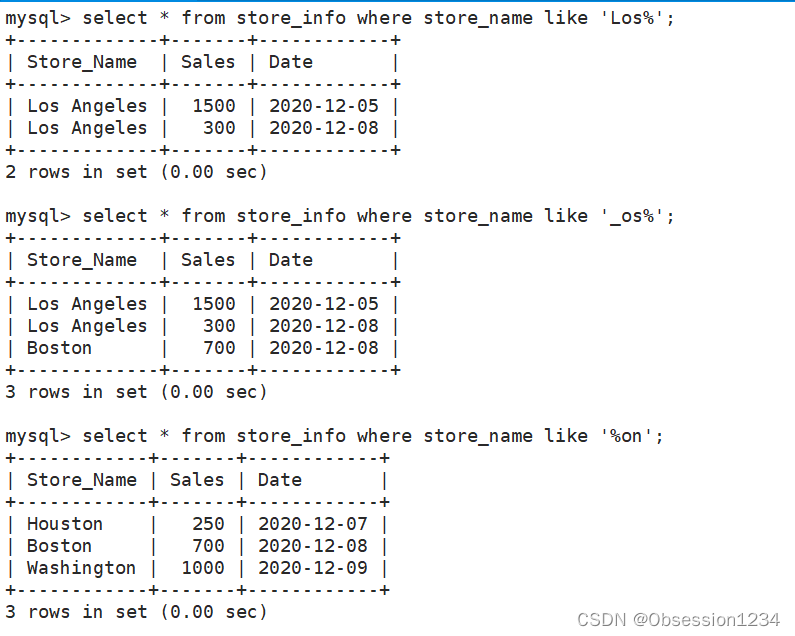
9.order by
按关键字排序
语法:select "字段" from "表名" [ where "条件"] order by "字段" [asc,desc];
#ASC 是按照升序进行排序的,是默认的排序方式。
#DESC 是按降序方式进行排序。
select store_name,sales,date from store_info order by sales desc;
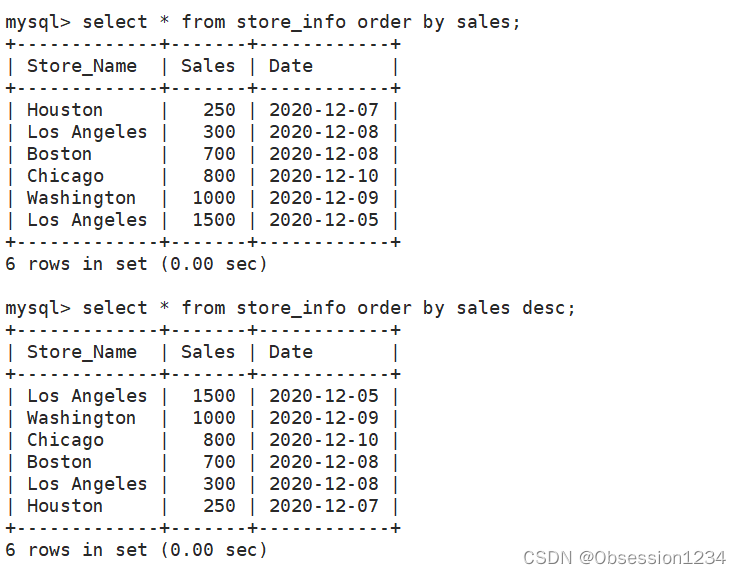

二.MySQL函数
1.数学函数
abs(x) 返回 x 的绝对值
rand() 返回 0 到 1 的随机数
mod(x,y) 返回 x 除以 y 以后的余数
power(x,y) 返回 x 的 y 次方
sqrt(x) 返回 x 的平方根
round(x) 返回离 x 最近的整数
round(x,y) 保留 x 的 y 位小数四舍五入后的值
truncate(x,y) 返回数字 x 截断为 y 位小数的值
ceil(x) 返回大于或等于 x 的最小整数
floor(x) 返回小于或等于 x 的最大整数
greatest(x1,x2...) 返回集合中最大的值,也可以返回多个字段的最大的值
least(x1,x2...) 返回集合中最小的值,也可以返回多个字段的最小的值


2.聚合函数
avg() 返回指定列的平均值
count() 返回指定列中非 NULL 值的个数
#count(*) 包括了所有的列的行数,在统计结果的时候,不会忽略列值为 NULL
#count(列名) 只包括列名那一列的行数,在统计结果的时候,会忽略列值为 NULL 的行
min() 返回指定列的最小值
max() 返回指定列的最大值
sum(x) 返回指定列的所有值之和

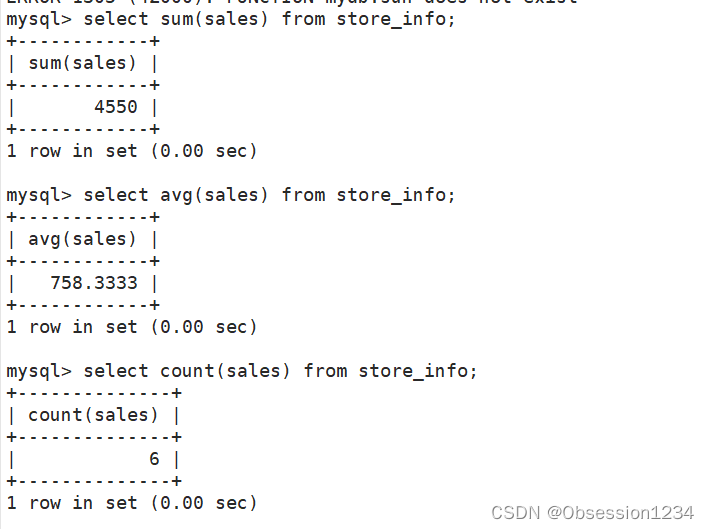
3.字符串函数
拓展:分割字符串的三种方法
[root@localhost ~]# i=abcdefg 定义变量
[root@localhost ~]# echo ${i:2:2} 第一种 下标从0开始
cd
[root@localhost ~]# expr substr $i 3 2 第二种 下标从1开始
cd
[root@localhost ~]# echo abcdefg | cut -b 3-4 第三种 下标从1开始
cd
concat(x,y) 将提供的参数 x 和 y 拼接成一个字符串
substr(x,y) 获取从字符串 x 中的第 y 个位置开始的字符串,跟substring()函数作用相同
substr(x,y,z) 获取从字符串 x 中的第 y 个位置开始长度为 z 的字符串
length(x) 返回字符串 x 的长度
replace(x,y,z) 将字符串 z 替代字符串 x 中的字符串 y
trim() 返回去除指定格式的值
upper(x) 将字符串 x 的所有字母变成大写字母
lower(x) 将字符串 x 的所有字母变成小写字母
left(x,y) 返回字符串 x 的前 y 个字符
right(x,y) 返回字符串 x 的后 y 个字符
repeat(x,y) 将字符串 x 重复 y 次
space(x) 返回 x 个空格
strcmp(x,y) 比较 x 和 y,返回的值可以为-1,0,1
reverse(x) 将字符串 x 反转
**upper **
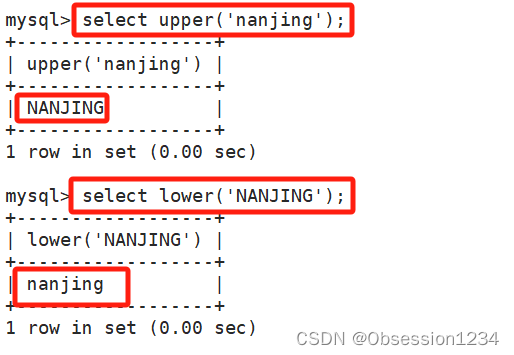
concat
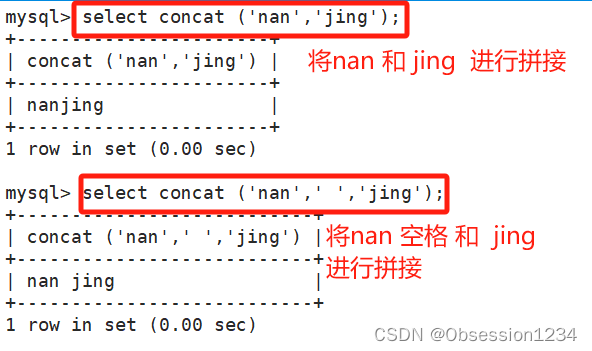
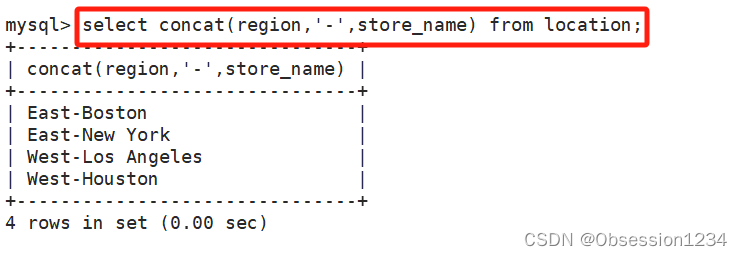
** 若在数据库的配置文件中加入了PIPES_AS_CONCAT的配置,也可以使用 || 来进行拼接**

substr
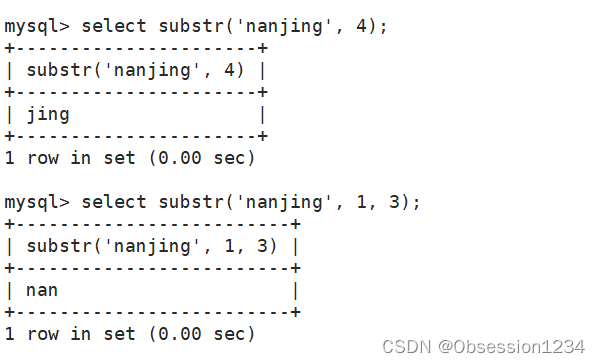
subtring
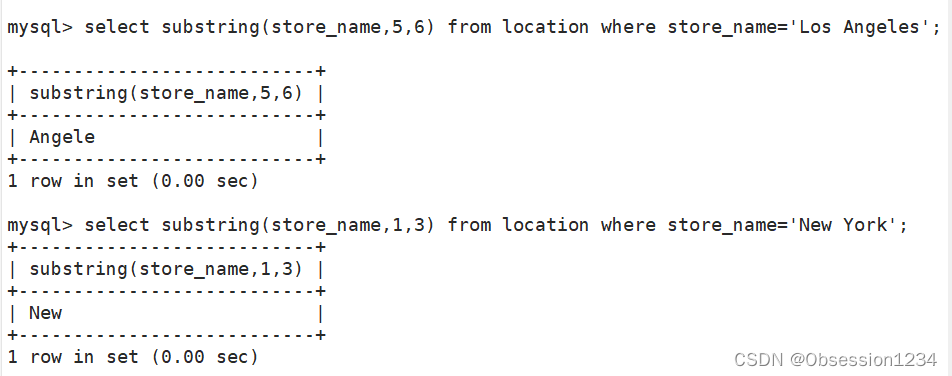
length
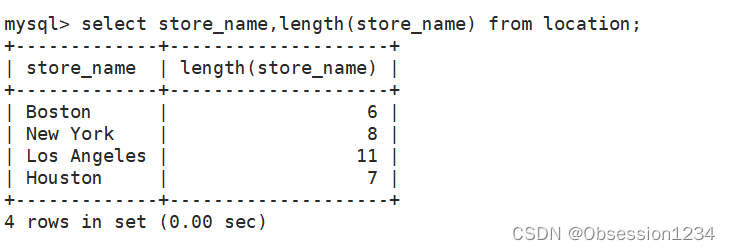
replace

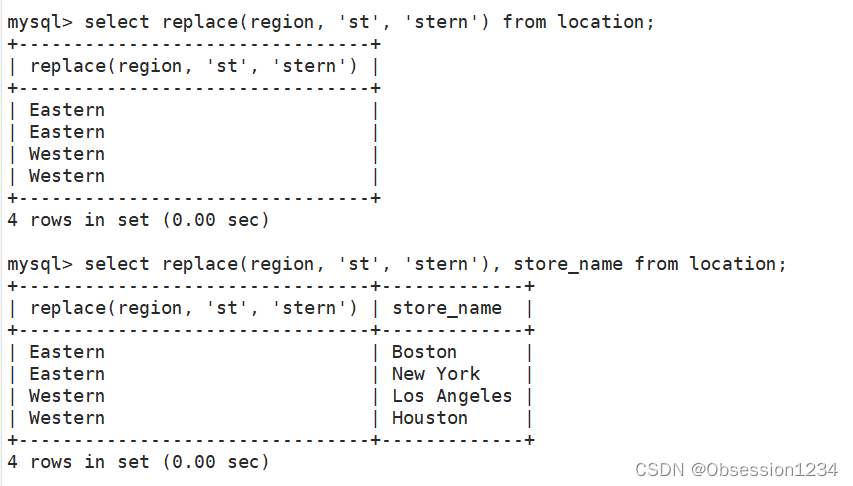
**trim **
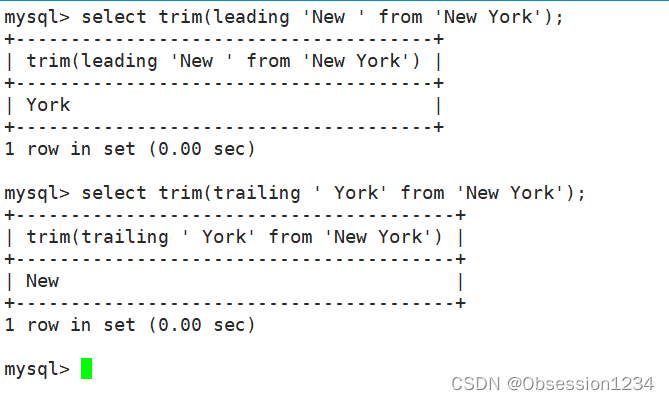
left 和 right
三.MySQL 查询函数
1.group by
对GROUP BY后面的字段的查询结果进行汇总分组,常是结合聚合函数一起使用的
GROUP BY 有一个原则,凡是在 GROUP BY 后面出现的字段,必须在 SELECT 后面出现;
凡是在 SELECT 后面出现的、且未在聚合函数中出现的字段,必须出现在 GROUP BY 后面;
语法:select "字段1", sum("字段2") from "表名" group by "字段1";
select store_name, sum(sales) from store_info group by store_name order bt sales desc;

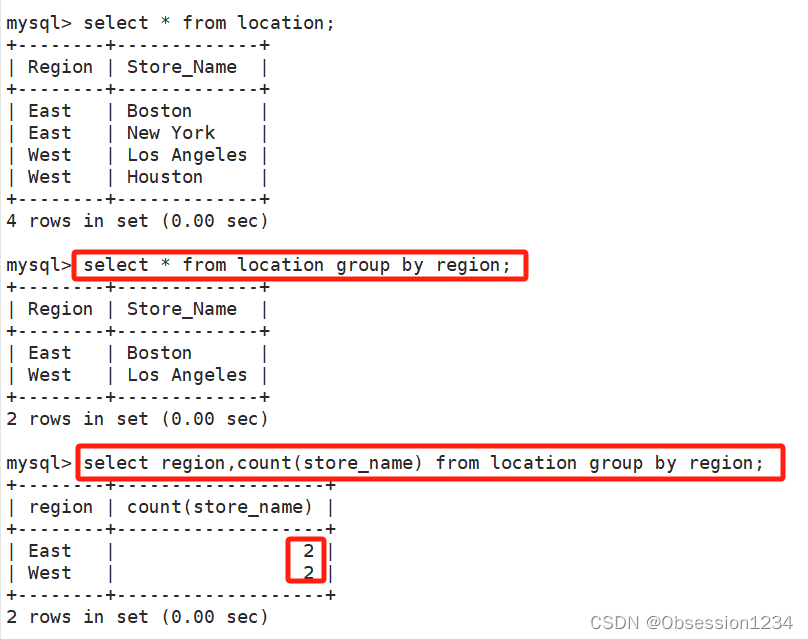
2.having
用来过滤由 GROUP BY 语句返回的记录集,常与 GROUP BY 语句联合使用
HAVING 语句的存在弥补了 WHERE 关键字不能与聚合函数联合使用的不足。
语法:select "字段1", sum("字段2") from "表格名" group by "字段1" having (函数条件);
select store_name, sum(sales) from store_info group by store_name having sum(sales) > 1000;
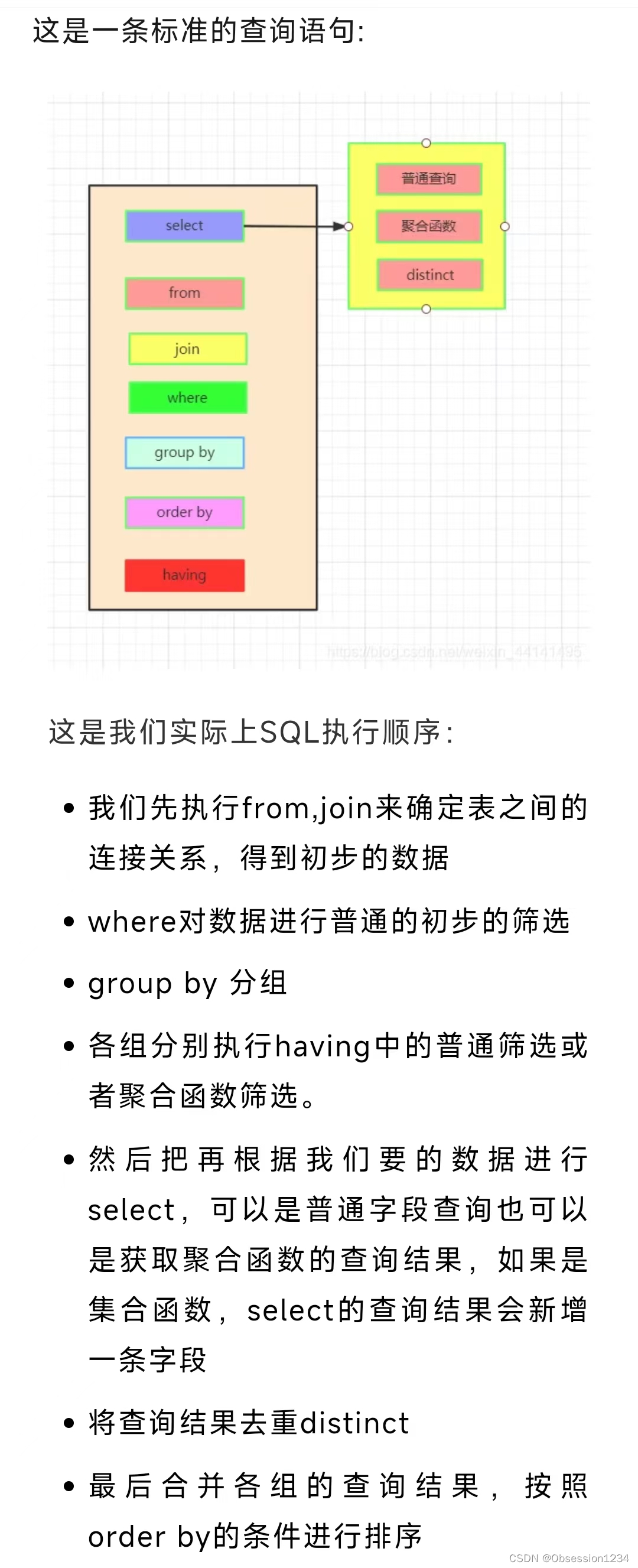

3.别名
字段別名 表格別名
语法:select "表格別名"."字段1" [as] "字段別名" from "表格名" [as] "表格別名";
select A.store_name store, sum(A.sales) "total sales" from store_info A group by A.store_name;



4.子查询
连接表格,在WHERE 子句或 HAVING 子句中插入另一个 SQL 语句
语法:select "字段1" from "表格1" where "字段2" [比较运算符] #外查询语句
(select "字段1" from "表格2" where "条件"); #内查询语句
#可以是符号的运算符,例如 =、>、<、>=、<=、!=;也可以是文字的运算符,例如 LIKE、IN、BETWEEN
select sum(sales) from store_info where store_name in (select store_name from location where region = 'West');

5.exists
用来根据条件过滤查询结果,并只返回满足条件的行
语法:select "字段1" from "表格1" where exists (select * from "表格2" where "条件");
#这里的子查询作为条件进行判断。如果子查询返回至少一行结果,则外部查询的结果将包含该行
select * from store_info A where exists (select Store_Name from location B where B.store_name = A.store_name);

四.表连接查询
1.连接查询方式
inner join(内连接):只返回两个表中联结字段相等的行
left join(左连接):返回包括左表中的所有记录和右表中联结字段相等的记录
right join(右连接):返回包括右表中的所有记录和左表中联结字段相等的记录
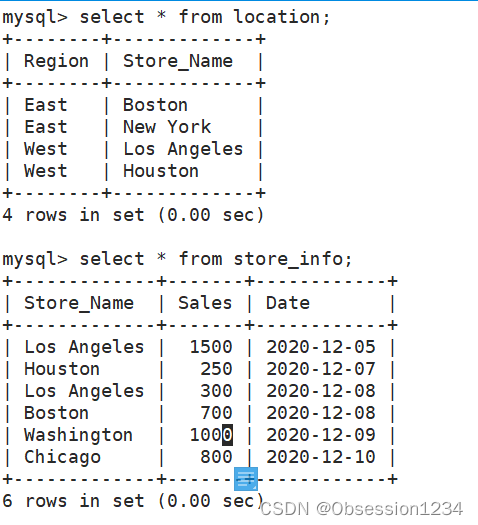
1.内连接
只返回两个表中联结字段相等的行
select A.store_name from store_info A inner join location B on A.store_name= B.store_name;

2.左连接
返回包括左表中的所有记录和右表中联结字段相等的记录
select * from location A left join store_info B on A.store_name = B.store_name;

3.右连接
返回包括右表中的所有记录和左表中联结字段相等的记录
select * from location A right join store_info B on A.store_name = B.store_name;

4.full outer join 全外连接
是一种特殊的连接,返回左表和右表中所有的行记录,但是MySQL不支持
5.交集值
取两个SQL语句结果的交集
(1)内连接
内连接:
select A.字段 from 左表 A inner join 右表 B on A.字段=B.字段;
select A.字段 from 左表 A inner join 右表 B using(字段);
select A.store_name from store_info A inner join location B on A.store_name= B.store_name;
select distinct A.store_name from store_info A inner join location B on A.store_name= B.store_name;
#去除重复值
select A.store_name from store_info A inner join location B using(store_name);


(2) 左连接
左连接:
select B.字段 from 左表 A left join 右表 B on A.字段 = B.字段 where B.字段 is not null;
select B.store_name from location A left join store_info B on A.store_name = B.store_name where B.store_name is not null;
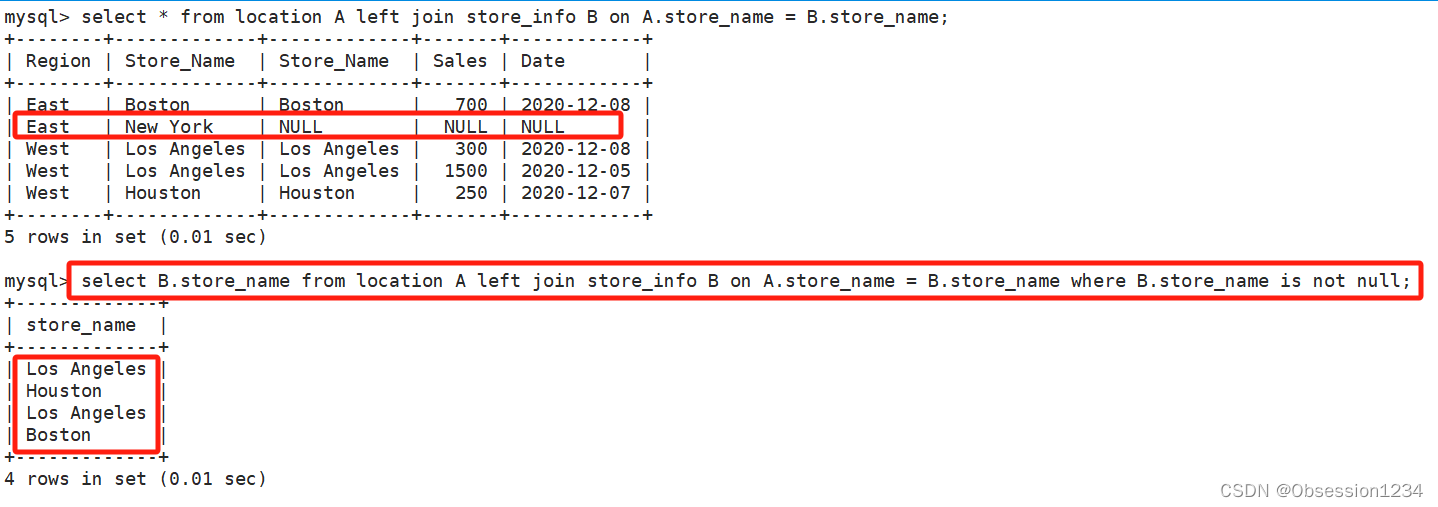
(3) 右连接
右连接:
select A.字段 from 左表 A left join 右表 B on A.字段 = B.字段 where A.字段 is not null;
select A.store_name from location A right join store_info B on A.store_name = B.store_name where A.store_name is not null;
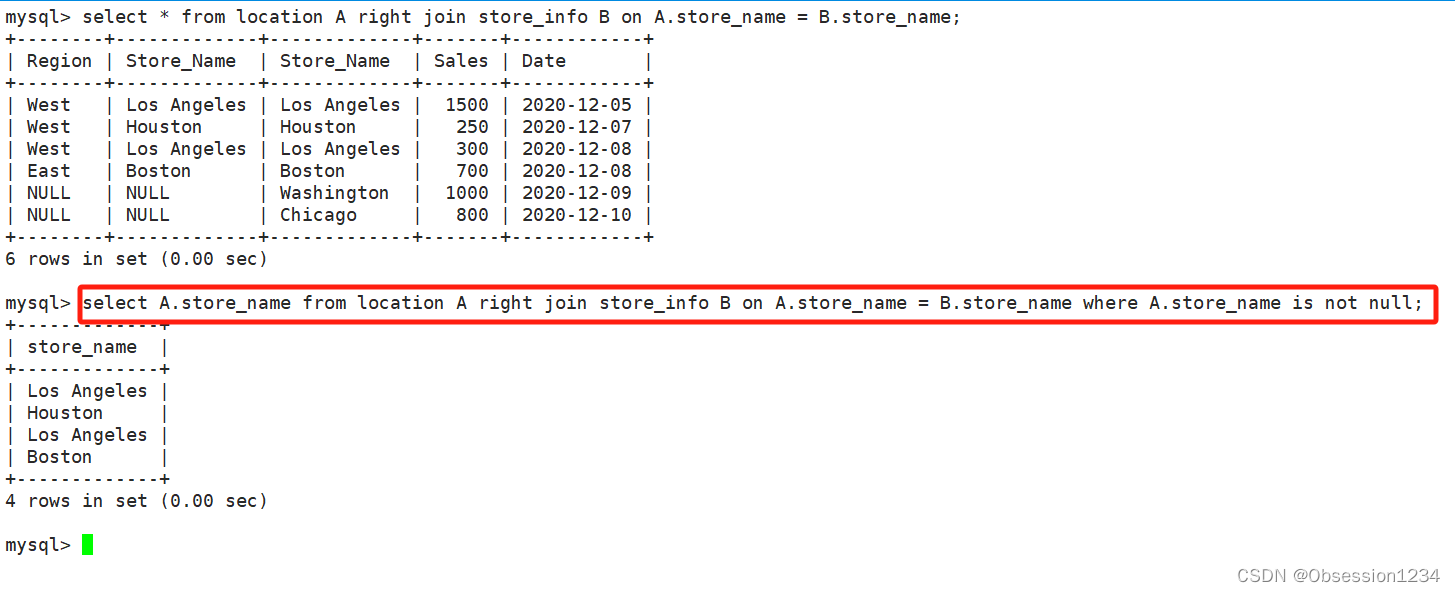
(4)子查询
select A.字段 from 左表 A where A.字段 in (select B.字段 from 右表 B);
select A.字段 from 左表 A where exists (select B.字段 from 右表 B where A.字段 = B.字段);
select store_name from store_info A where A.store_name in (select B.store_name from location B);
select A.store_name from store_info A where exists (select B.store_name from location B where A.store_name = B.store_name);
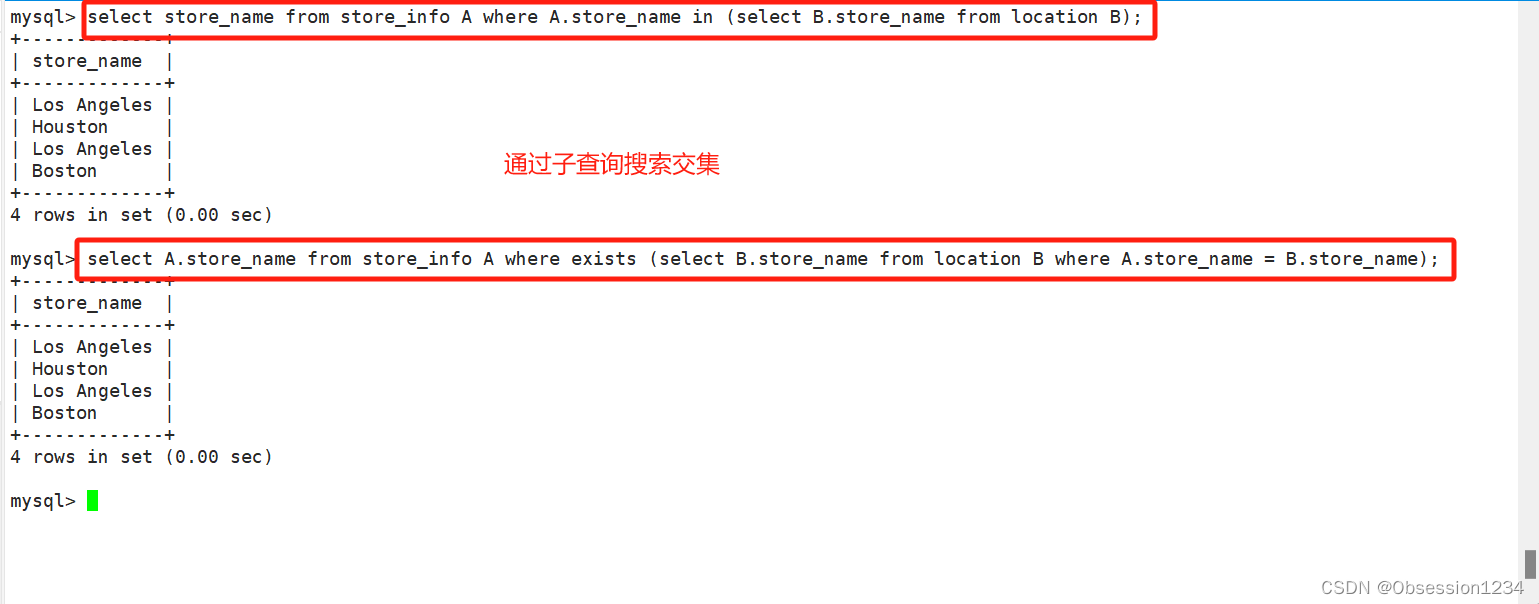
(5)多表查询
select A.字段 from 左表 A, 右表 B where A.字段 = B.字段;
select A.store_name from store_info A, location B where A.store_name = B.store_name;

(6)联集+分组
联集,将两个SQL语句的结果合并起来,两个SQL语句所产生的字段需要是同样的数据记录种类
UNION :生成结果的数据记录值将没有重复,且按照字段的顺序进行排序
union 联集语法:
[select 语句 1] union [select 语句 2];
union all :将生成结果的数据记录值都列出来,无论有无重复
语法:[select 语句 1] union all [select 语句 2];


联集+分组:语法
select A.字段 from (select distinct 字段 from 左表 union all select distinct 字段 from 右表) A表 group by A.字段 having count(A.字段) > 1;
#此处的 A表 是由内查询语句返回的结果 抽象出的派生表
select A.store_name from (select distinct store_name from store_info union all select distinct store_name from location) A groupby A.store_name having count(A.store_name) > 1;

6.无交集值
显示第一个SQL语句的结果,且与第二个SQL语句没有交集的结果,且没有重复
(1)求左表无交集
select A.字段 from 左表 A left join 右表 B on A.字段 = B.字段 where B.字段 is null;
select 字段 from 左表 where 字段 not in (select 字段 from 右表);
select A.字段 from 左表 A where not exists (select B.字段 from 右表 B where A.字段 = B.字段);
select A.store_name from location A left join store_info B on A.store_name = B.store_name where B.store_name is null;
select store_name from location where store_name not in (select store_name from store_info);
select A.store_name from location A where not exists (select B.store_name from store_info B where A.store_name = B.store_name);
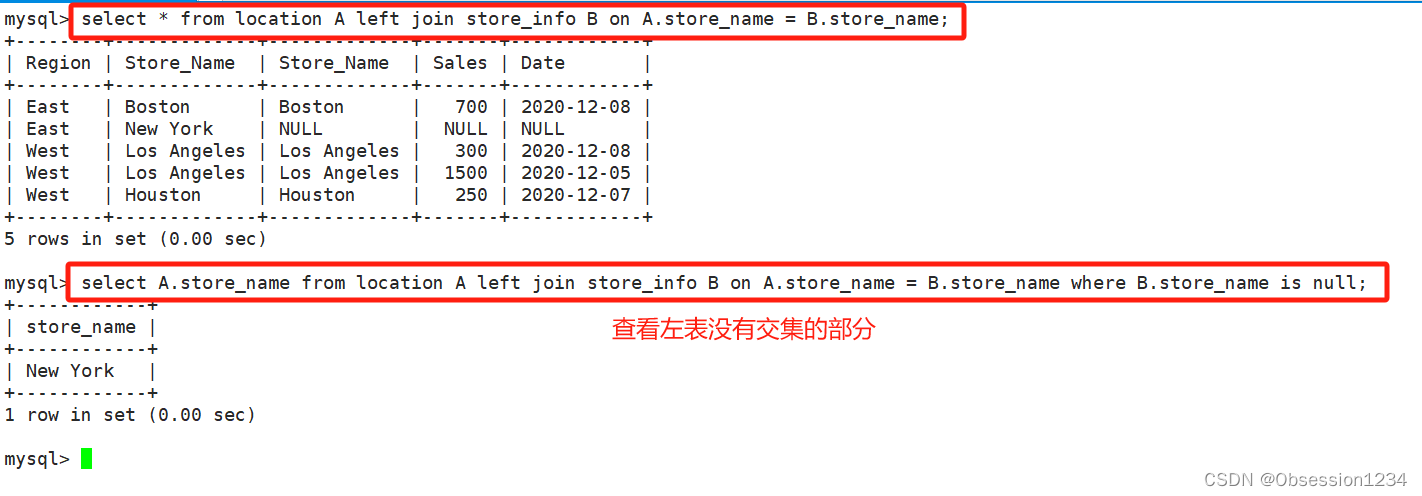


(2)求右表无交集
select B.字段 from 左表 A right join 右表 B on A.字段 = B.字段 where A.字段 is null;
select 字段 from 右表 where 字段 not in (select 字段 from 左表);
select A.字段 from 右表 A where not exists (select B.字段 from 左表 B where A.字段 = B.字段);
select B.store_name from location A right join store_info B on A.store_name = B.store_name where A.store_name is null;
select store_name from store_info where store_name not in (select store_name from location);
select A.store_name from store_info A where not exists (select B.store_name from location B where A.store_name = B.store_name);
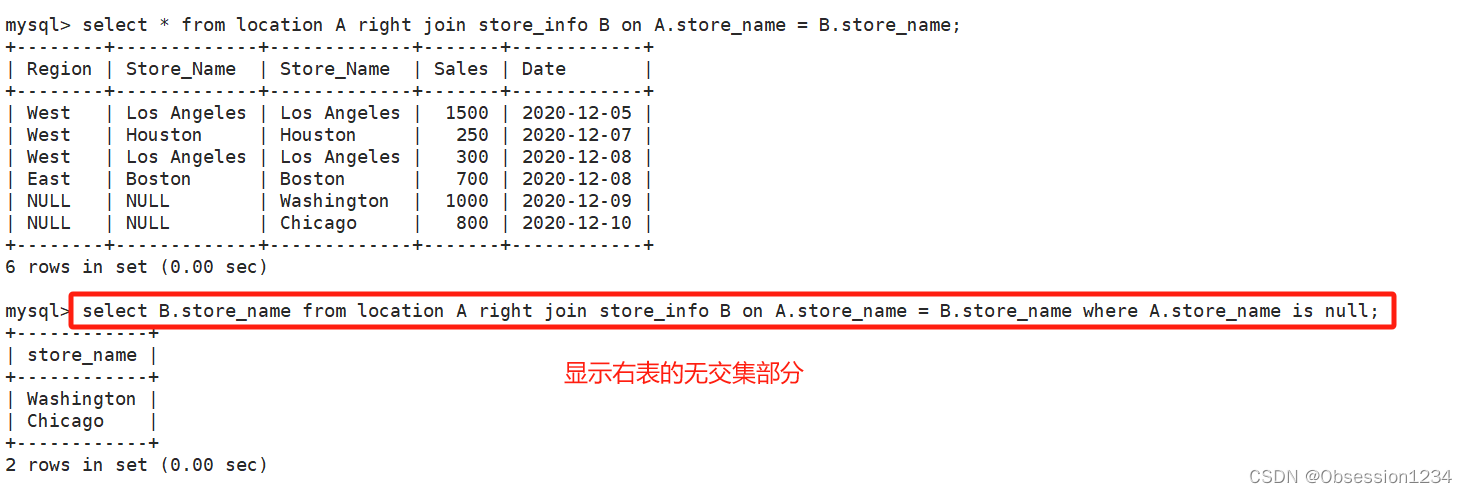


(3)求两个表无交集
select A.字段 from 左表 A left join 右表 B on A.字段 = B.字段 where B.字段 is null
union all
select B.字段 from 左表 A right join 右表 B on A.字段 = B.字段 where A.字段 is null;
select A.字段 from (select distinct 字段 from 左表 union all select distinct 字段 from 右表) A group by A.字段 having count(A.字段) = 1;
select A.store_name from location A left join store_info B on A.store_name = B.store_name where B.store_name is null
-> union all
-> select B.store_name from location A right join store_info B on A.store_name = B.store_name where A.store_name is null;
select A.store_name from (select distinct store_name from store_info union all select distinct store_name from location) A group
by A.store_name having count(A.store_name) = 1;


版权归原作者 Obsession1234 所有, 如有侵权,请联系我们删除。
